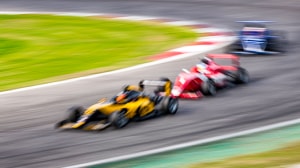Miami International Autodrome, Miami Gardens, Florida
Background
The Formula One (F1) Grand Prix is the premier international auto racing competition for single-seater formula racing cars. F1 had chosen the Miami International Autodrome as the venue for an upcoming race.
The Autodrome is built around Hard Rock Stadium. In preparation for the coming race, the paddock area was being remodeled.

At the Miami International Autodrome, the paddock includes a four-story building located at the start/finish line of the racetrack (in F1 parlance referred to as the circuit). Between this building and the racetrack, there are identical paddock pods; each pod serves as the central hub for each team’s important operations during the Formula 1 Miami Grand Prix.
This particular project was focused on remodeling the paddock pods.
Challenge
Before, during, and after an F1 race, the paddock pods remain a highly active and dynamic environment, functioning as the operational nerve center of important team functions, each with its own space:
Team Garages Where each team conducts car maintenance, setup, and real-time race management.
Pit Lane Access Direct routes from the team’s garages to the pit lane that facilitate efficient pit stops and on-track interventions.
Technical Facilities Areas equipped for tire storage, fuel management, and housing essential equipment.
Operational Zones Dedicated spaces for scrutineering, medical support, and other critical race control functions.
To meet the exacting demands of each of these spaces, superior lighting was crucial for ensuring efficiency, precision, and safety.
Specifically, the new lighting design had to offer high illumination so team members could complete complicated mechanical and technical precision work. And the lighting had to be uniform, leaving no shadows that could slow down team members when every fraction of a second counts.
Optimal color temperatures were needed for natural light conditions to provide team members with accurate visibility of components and diagnostics. High CRI was also needed for true color rendering, critical for the team’s tire wear analysis, wiring identification, and fluid level checks. Avoiding glare was a serious concern, as well. Any glare on glossy fiber surfaces, screens, and other reflective surfaces had to be kept at a bare minimum.
Not least important, backup power was needed to ensure the lights would stay on even during power fluctuations.
And of course, smart lighting controls were needed to be sure the lighting was optimized at all times and every team member was working with the right illumination for the task at hand.
Solution
The key to meeting all these requirements was the LightLEEDer lighting control system from ILC (Intelligent Lighting Controls). ILC lighting controls are part of the Cooper Lighting Solutions offering.
The LightLEEDer is a lighting control solution designed to provide reliable, flexible lighting management and enhanced energy efficiency.
For the F1 paddock pods, a connected network lighting control system with advanced features was created using LightLEEDer programmable lighting control relay panels, known for their dependability, flexibility, and energy efficiency. The panels come with ILC’s new Reliant40 relays which feature a superior 4-contact design. The LightLEEDer panels also include a keyboard and LCD screen, as well as USB and TCP/IP connections for easy programming with ILC’s free LightLEEDer Pro Software.

Dual technology sensors helped conserve energy by dimming or extinguishing the lights when no team members were in the room.
The paddock pod area was also equipped with reliable and code-compliant emergency lighting from ILC.
Please see “Product Used” below for a comprehensive list of all the ILC products used.
Results
The ILC LightLEEDer connected network lighting control system was a winning choice for the F1 paddock pods. It provided the high-performance illumination the F1 teams needed for every aspect of their behind-the-scenes Grand Prix success.
Here are just some of the benefits the LightLEEDer system’s capabilities made possible:
Integrated Control: Strategies such as occupancy detection, personal control, and zoning allowed for adaptable lighting solutions that can be tailored to specific team needs.
Flexibility: The LightLEEDer system supported a wide range of control strategies. And if the need required, the system could easily have been adapted to changes in space usage or layout without requiring significant rewiring or hardware changes.
Superior Control and Management: Lighting fixtures could be controlled by relays for precise adjustments in lighting levels, color, and timing.

Energy Savings and Flexibility: The paddock pods saved up to 70% in lighting energy costs by incorporating lighting control strategies.
Ease of Use: BACNET was installed so users could control the system easily from any internet-connected device via a user-friendly, web-based interface.
Open Protocol: LightLEEDer Lightsync control ensured compatibility with devices from multiple manufacturers.
Products Used
- 8 LightLEEDer Panel, Capacity for 16 R40-1 Relays
- 4 LightLEEDer Panel, Capacity for 24 R40-1 Relays
- 224 Reliant 40 Amp Relay
- 1 LightLEEDer Network Controller
- 1 LightLEEDer Serial Interface
- 1 LightSync Input Module
- 56 LightSync Dimming Module
- 1 LightSync Power Supply Repeater
- 24 Wall Switch Sensor Dual, Tech
- 40 Ceiling Sensor Dual, Tech
- 20 Power Pack
- 60 Emergency Power Control Bypass Shunt Relay
- 1 Factory Sunmittal Package
- 1 Factory Start-Up 5-Day
- 1 Factory Start-Up 1-Day
- 28 LightSunc Touchscreen
- 2 Sub Assembly, LL Double Input Plate, and Hardware for Retrofit Panels
- 1 LightLEEDer Transformer 24 VAC

